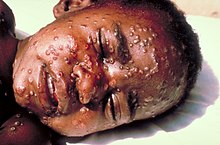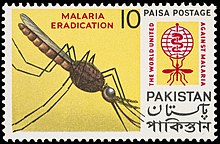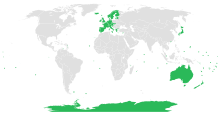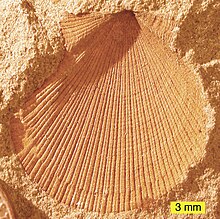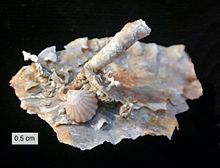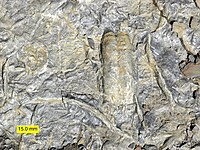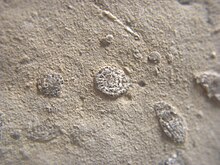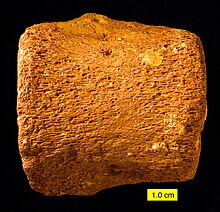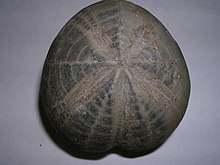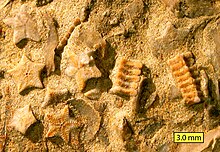Eradication is the reduction of an infectious disease's prevalence in the global host population to zero. It is sometimes confused with elimination, which describes either the reduction of an infectious disease's prevalence in a regional population to zero or the reduction of the global prevalence to a negligible amount. Further confusion arises from the use of the term eradication to refer to the total removal of a given pathogen from an individual (also known as clearance of an infection), particularly in the context of HIV and certain other viruses where such cures are sought.
The selection of infectious diseases for eradication is based on rigorous criteria, as both biological and technical features determine whether a pathogenic organism is (at least potentially) eradicable. The targeted organism must not have a non-human reservoir (or, in the case of animal diseases, the infection reservoir must be an easily identifiable species, as in the case of rinderpest), and/or amplify in the environment. This implies that sufficient information on the life cycle and transmission dynamics is available at the time an eradication initiative is programmed. An efficient and practical intervention (such as a vaccine or antibiotic) must be available to interrupt transmission of the infective agent. Studies of measles in the pre-vaccination era led to the concept of the critical community size, the size of the population below which a pathogen ceases to circulate. The use of vaccination programs before the introduction of an eradication campaign can reduce the susceptible population. The disease to be eradicated should be clearly identifiable, and an accurate diagnostic tool should exist. Economic considerations, as well as societal and political support and commitment, are other crucial factors that determine eradication feasibility.
Two infectious diseases have successfully been eradicated: smallpox and rinderpest. There are also four ongoing programs, targeting poliomyelitis, yaws, dracunculiasis, and malaria. Five more infectious diseases have been identified as of April 2008 as potentially eradicable with current technology by the Carter Center International Task Force for Disease Eradication—measles, mumps, rubella, lymphatic filariasis and cysticercosis.
Eradicated diseases
So far, two diseases have been successfully eradicated—one specifically affecting humans (smallpox), and one affecting a wide range of ruminants (rinderpest).
Smallpox
Smallpox was the first disease, and so far the only infectious disease of humans, to be eradicated by deliberate intervention. It became the first disease for which there was an effective vaccine in 1798 when Edward Jenner showed the protective effect of inoculation (vaccination) of humans with material from cowpox lesions.
Smallpox (variola) occurred in two clinical varieties: variola major, with a mortality rate of up to 40 percent, and variola minor, also known as alastrim, with a mortality rate of less than one percent. The last naturally occurring case of Variola major was diagnosed in October 1975 in Bangladesh. The last naturally occurring case of smallpox (Variola minor) was diagnosed on 26 October 1977, on Ali Maow Maalin, in the Merca District, of Somalia. The source of this case was a known outbreak in the nearby district of Kurtuware. All 211 contacts were traced, revaccinated, and kept under surveillance.
After two years' detailed analysis of national records, the global eradication of smallpox was certified by an international commission of smallpox clinicians and medical scientists on 9 December 1979, and endorsed by the General Assembly of the World Health Organization on 8 May 1980. However, there is an ongoing debate regarding the continued storage of the smallpox virus by labs in the US and Russia, as any accidental or deliberate release could create a new epidemic in people born since the late 1980s due to the cessation of vaccinations against the smallpox virus.
Rinderpest
During the twentieth century, there were a series of campaigns to eradicate rinderpest, a viral disease which infected cattle and other ruminants and belonged to the same family as measles, primarily through the use of a live attenuated vaccine. The final, successful campaign was led by the Food and Agriculture Organization of the United Nations. On 14 October 2010, with no diagnoses for nine years, the Food and Agriculture Organization announced that the disease had been completely eradicated, making this the first (and so far the only) disease of livestock to have been eradicated by human undertakings.
Global eradication underway
Poliomyelitis (polio)
| Year | Estimated | Recorded |
|---|---|---|
| 1975 | — | 49,293 |
| 1980 | 400,000 | 52,552 |
| 1985 | — | 38,637 |
| 1988 | 350,000 | 35,251 |
| 1990 | — | 23,484 |
| 1993 | 100,000 | 10,487 |
| 1995 | — | 7,035 |
| 2000 | — | 2,971 |
| 2005 | — | 1,998 |
| 2010 | — | 1,352 |
| 2011 | — | 650 |
| 2012 | — | 222 |
| 2013 | — | 385 |
| 2014 | — | 359 |
| 2015 | — | 74 |
| 2016 | — | 37 |
| 2017 | — | 22 |
| 2018 | — | 33 |
| 2019 | — | 176 |
A dramatic reduction of the incidence of poliomyelitis in industrialized countries followed the development of a vaccine in the 1950s. In 1960, Czechoslovakia became the first country certified to have eliminated polio.
In 1988, the World Health Organization (WHO), Rotary International, the United Nations Children's Fund (UNICEF), and the United States Centers for Disease Control and Prevention (CDC) passed the Global Polio Eradication Initiative. Its goal was to eradicate polio by the year 2000. The updated strategic plan for 2004–2008 expects to achieve global eradication by interrupting poliovirus transmission, using the strategies of routine immunization, supplementary immunization campaigns, and surveillance of possible outbreaks. The WHO estimates that global savings from eradication, due to forgone treatment and disability costs, could exceed one billion U.S. dollars per year.
The following world regions have been declared polio-free:
- The Americas (1994)
- Indo-West Pacific region (1997)
- Europe (1998)
- Western Pacific region, including China (2000)
- Southeast Asia region (2014), including India
- Africa (2020)
The lowest annual wild polio prevalence seen so far was in 2017, with only 22 reported cases, although there were more total reported cases (including circulated vaccine-derived cases) than in 2016, mainly due to reporting of circulated vaccine-derived cases in Syria, where it likely had already been circulating, but gone unreported, presumably due to the civil war. Only two or three countries remain in which poliovirus transmission may never have been interrupted: Pakistan, Afghanistan, and perhaps Nigeria. (There have been no cases caused by wild strains of poliovirus in Nigeria since August 2016, though cVDPV2 was detected in environmental samples in 2017.) Nigeria was removed from the WHO list of polio-endemic countries in September 2015 but added back in 2016, and India was removed in 2014 after no new cases were reported for one year.
On 20 September 2015, the World Health Organization announced that wild poliovirus type 2 had been eradicated worldwide, as it has not been seen since 1999. On 24 October 2019, the World Health Organization announced that wild poliovirus type 3 had also been eradicated worldwide. This leaves only wild poliovirus type 1 and circulating vaccine-derived polio circulating in a few isolated pockets, with all wild polio cases after August 2016 in Afghanistan and Pakistan.
Dracunculiasis
| Year | Reported cases | Countries |
|---|---|---|
| 1989 | 892,055 | 16 |
| 1995 | 129,852 | 19 |
| 2000 | 75,223 | 16 |
| 2005 | 10,674 | 12 |
| 2010 | 1,797 | 6 |
| 2011 | 1,060 | 4 |
| 2012 | 542 | 4 |
| 2013 | 148 | 5 |
| 2014 | 126 | 4 |
| 2015 | 22 | 4 |
| 2016 | 25 | 3 |
| 2017 | 30 | 2 |
| 2018 | 28 | 3 |
| 2019 | 54 | 4 |
| 2020 | 24 | 4 |
Dracunculiasis, also called Guinea worm disease, is a painful and disabling parasitic disease caused by the nematode Dracunculus medinensis. It is spread through consumption of drinking water infested with copepods hosting Dracunculus larvae. The Carter Center has led the effort to eradicate the disease, along with the CDC, the WHO, UNICEF, and the Bill and Melinda Gates Foundation.
Unlike diseases such as smallpox and polio, there is no vaccine or drug therapy for guinea worm. Eradication efforts have been based on making drinking water supplies safer (e.g. by provision of borehole wells, or through treating the water with larvicide), on containment of infection and on education for safe drinking water practices. These strategies have produced many successes: two decades of eradication efforts have reduced Guinea worm's global incidence to 22 cases in 2015, after which cases rose to 25 cases in 2016, and 30 cases in 2017, but this is still down from an estimated 3.5 million in 1986. Success has been slower than was hoped—the original goal for eradication was 1995. The WHO has certified 180 countries free of the disease, and only three countries—South Sudan, Ethiopia, and Chad—reported cases of guinea worm in 2016, and only two—Ethiopia and Chad—in 2017. As of 2010, the WHO predicted it would be "a few years yet" before eradication is achieved, on the basis that it took 6–12 years for the countries that have so far eliminated guinea worm transmission to do so after reporting a similar number of cases to that reported by Sudan in 2009. The number of cases in 2019 (54) was less than 2% of the number in 2009, so real progress has been made towards this prediction. Nonetheless, the last 1% may be the hardest, and cases have increased from 2015 (22) to 2019 (54). The worm is able to infect dogs, domestic cats and baboons as well as humans, complicating eradication efforts.
Yaws
Yaws is a rarely fatal but highly disfiguring disease caused by the spiral-shaped bacterium (spirochete) Treponema pallidum pertenue, a close relative of the syphilis bacterium Treponema pallidum pallidum, spread through skin to skin contact with infectious lesions. The global prevalence of this disease and the other endemic treponematoses, bejel and pinta, was reduced by the Global Control of Treponematoses (TCP) programme between 1952 and 1964 from about 50 million cases to about 2.5 million (a 95% reduction). However, following the cessation of this program these diseases remained at a low prevalence in parts of Asia, Africa and the Americas with sporadic outbreaks. According to a 2012 official WHO roadmap, the elimination should be achievable by 2020. Yaws is currently targeted by the South-East Asian Regional Office of the WHO for elimination from the remaining endemic countries in this region (India, Indonesia and East Timor) by 2010, and so far, this appears to have met with some success, since no cases have been seen in India since 2004. The discovery that oral antibiotic azithromycin can be used instead of the previous standard, injected penicillin, was tested on Lihir Island from 2013 to 2014; a single oral dose of the macrolide antibiotic reduced disease prevalence from 2.4% to 0.3% at 12 months. The campaign was in an early stage in 2013, still gathering data on disease incidence and planning initial large-scale treatment campaigns in Cameroon, Ghana, Indonesia, Papua New Guinea, the Solomon Islands, and Vanuatu.
Malaria
Malaria has been eliminated from most of Europe, North America, Australia, North Africa and the Caribbean, and parts of South America, Asia and Southern Africa. The WHO defines elimination as having no domestic transmission for the past three years. They also define an "elimination stage" when a country is on the verge of eliminating malaria, as being less than one case per 1000 people at risk per year. As of 2019, 38 countries are certified as having eliminated malaria. As of 2018, 21 countries were seeking to eliminate malaria by 2020. The pre-elimination stage entails fewer than 5 cases per 1000 people at risk per year.
In 1955 the WHO launched the Global Malaria Eradication Program (GMEP). Support waned, and the program was suspended in 1969. Since 2000, support for eradication has increased, although some people in the global health community remain sceptical. According to the WHO's World Malaria Report 2015, the global mortality rate for malaria fell by 60% between 2000 and 2015. The WHO aims to achieve a further 90% reduction between 2015 and 2030. Bill Gates believes that global eradication is possible by 2040.
A major challenge to malaria elimination is the persistence of malaria in border regions, making international cooperation crucial.
Regional elimination established or underway
Some diseases have already been eliminated from large regions of the world, and/or are currently being targeted for regional elimination. This is sometimes described as "eradication", although technically the term only applies when this is achieved on a global scale. Even after regional elimination is successful, interventions often need to continue to prevent a disease becoming re-established. Three of the diseases here listed (lymphatic filariasis, measles, and rubella) are among the diseases believed to be potentially eradicable by the International Task Force for Disease Eradication, and if successful, regional elimination programs may yet prove a stepping stone to later global eradication programs. This section does not cover elimination where it is used to mean control programs sufficiently tight to reduce the burden of an infectious disease or other health problem to a level where they may be deemed to have little impact on public health, such as the leprosy, neonatal tetanus, or obstetric fistula campaigns.
Hookworm
In North American countries, such as the United States, elimination of hookworm had been attained due to scientific advances. Despite the United States declaring that it had eliminated hookworm decades ago, a 2017 study showed it was present in Lowndes County, Alabama.
The Rockefeller Foundation's hookworm campaign in the 1920s was supposed to focus on the eradication of hookworm infections for those living in Mexico and other rural areas. However, the campaign was politically influenced, causing it to be less successful, and regions such as Mexico still deal with these infections from parasitic worms. This use of health campaigns by political leaders for political and economic advantages has been termed the science-politics paradox.
Lymphatic filariasis
Lymphatic filariasis is an infection of the lymph system by mosquito-borne microfilarial worms which can cause elephantiasis. Studies have demonstrated that transmission of the infection can be broken when a single dose of combined oral medicines is consistently maintained annually for approximately seven years. The strategy for eliminating transmission of lymphatic filariasis is mass distribution of medicines that kill the microfilariae and stop transmission of the parasite by mosquitoes in endemic communities. In sub-Saharan Africa, albendazole is being used with ivermectin to treat the disease, whereas elsewhere in the world albendazole is used with diethylcarbamazine. Using a combination of treatments better reduces the number of microfilariae in blood. Avoiding mosquito bites, such as by using insecticide-treated mosquito bed nets, also reduces the transmission of lymphatic filariasis. In the Americas, 95% of the burden of lymphatic filariasis is on the island of Hispaniola (comprising Haiti and the Dominican Republic). An elimination effort to address this is currently under way alongside the malaria effort described above; both countries intend to eliminate the disease by 2020.
As of October 2008, the efforts of the Global Programme to Eliminate LF are estimated to have already prevented 6.6 million new filariasis cases from developing in children, and to have stopped the progression of the disease in another 9.5 million people who have already contracted it. Overall, of 83 endemic countries, mass treatment has been rolled out in 48, and elimination of transmission reportedly achieved in 21.
Measles
Five out of six WHO regions have goals to eliminate measles, and at the 63rd World Health Assembly in May 2010, delegates agreed to move towards eventual eradication, although no specific global target date has yet been agreed. The Americas set a goal in 1994 to eliminate measles and rubella transmission by 2000, and successfully achieved regional measles elimination in 2002, although there have been occasional small outbreaks from imported cases since then. Europe had set a goal to eliminate measles transmission by 2010, but were hindered by the MMR vaccine controversy and by low uptake in certain groups, and despite achieving low levels by 2008, European countries have since experienced a small resurgence in cases. They have set a new target of 2015. The Eastern Mediterranean also had goals to eliminate measles by 2010 (later revised to 2015), the Western Pacific aims to eliminate the disease by 2012, and in 2009 the regional committee for Africa agreed a goal of measles elimination by 2020. As of May 2010, only the South-East Asian region has yet to set a target date for elimination of measles transmission.
In 2005, a global target was agreed for a 90% reduction in measles deaths by 2010 from the 757,000 deaths in 2000; estimates for 2008 show a 78% decline so far to 164,000 deaths. However, some have been pushing to attempt global eradication. This was updated at the 2010 World Health Assembly to a targeted 95% reduction in mortality by 2015, alongside specific vaccination and structural targets, and in a meeting in November 2010, the Strategic Advisory Group of Experts on Immunization "concluded that measles can and should be eradicated". A study of the costs of eradicating measles compared to the costs of maintaining indefinite control was commissioned in 2009 by the WHO and the Bill and Melinda Gates Foundation. In 2013, measles deaths globally were down to 145,700.
As of mid-2013, measles elimination in many areas is stalling. "This year, measles and rubella outbreaks are occurring in many areas of the world where people have no immunity to these viruses. The reasons people are unvaccinated range from lack of access to vaccines in areas of insecurity, to poor performing health systems, to vaccine refusals. We need to address each of these challenges if we’re going to meet global measles and rubella elimination goals," said Dr. Myrna Charles of the American Red Cross, as reported in a post in the Measles and Rubella Initiative's blog. A look at the WHO's epidemiological graph of measles over time from 2008-2013 show that, with little more of two years to go to 2015, measles cases in 2013 are moving in the wrong direction, with more cases this year than at the same point in 2012 or 2011.
During 2014 there were 23 outbreaks of measles in the United States and over 600 individual cases, which is the highest seen in decades. In 2015 the US has had one major outbreak of measles originating from an amusement park in California of a variant of the virus circulating in the Philippines in 2014. From this there have been 113 individual measles cases and one death (out of the total of 189 cases in the US in 2015).
The WHO region of the Americas declared on 27 September 2016 it had eliminated measles. The last confirmed endemic case of measles in the Americas was in Brazil in July 2015. May 2017 saw a return of measles to the US after an outbreak in Minnesota among unvaccinated children. Another outbreak occurred in the state of New York between 2018 and 2019, causing over 200 confirmed measles cases in mostly ultra-Orthodox Jewish communities. Subsequent outbreaks occurred in New Jersey and Washington state with over 30 cases reported in the Pacific Northwest.
Rubella
Four out of six WHO regions have goals to eliminate rubella, with the WHO recommending using existing measles programmes for vaccination with combined vaccines such as the MMR vaccine. The number of reported cases dropped from 670 thousand in the year 2000 to below 15 thousand in 2018, and the global coverage of rubella vaccination was estimated at 69% in 2018 by the WHO. The WHO region of the Americas declared on 29 April 2015 it had eliminated rubella and congenital rubella syndrome. The last confirmed endemic case of rubella in the Americas was in Argentina in February 2009. Australia achieved eradication in 2018. The WHO European region missed its elimination target of 2010 due to undervaccination in Central and Western Europe; it has set a new goal of 2015. The disease remains problematic in other regions; the WHO regions of Africa and South-East Asia have the highest rates of congenital rubella syndrome and a 2013 outbreak of rubella in Japan resulted in 15,000 cases.
Onchocerciasis
Onchocerciasis (river blindness) is the world's second leading cause of infectious blindness. It is caused by the nematode Onchocerca volvulus, which is transmitted to people via the bite of a black fly. Elimination of this disease is under way in the region of the Americas, where this disease was endemic to Brazil, Colombia, Ecuador, Guatemala, Mexico and Venezuela. The principal tool being used is mass ivermectin treatment. If successful, the only remaining endemic locations would be in Africa and Yemen. In Africa, it is estimated that greater than 102 million people in 19 countries are at high risk of onchocerciasis infection, and in 2008, 56.7 million people in 15 of these countries received community-directed treatment with ivermectin. Since adopting such treatment measures in 1997, the African Programme for Onchocerciasis Control reports a reduction in the prevalence of onchocerciasis in the countries under its mandate from a pre-intervention level of 46.5% in 1995 to 28.5% in 2008. Some African countries, such as Uganda, are also attempting elimination and successful elimination was reported in 2009 from two endemic foci in Mali and Senegal.
On 29 July 2013, the Pan American Health Organization (PAHO) announced that after 16 years of efforts, Colombia had become the first country in the world to eliminate the parasitic disease onchocerciasis. It has also been eliminated in Ecuador (2014), Mexico (2015), and Guatemala (2016).
Bovine spongiform encephalopathy (BSE) and new variant Creutzfeldt–Jakob disease (vCJD)
Following an epidemic of variant Creutzfeldt–Jakob disease (vCJD) in the UK in the 1990s, there have been campaigns to eliminate bovine spongiform encephalopathy (BSE) in cattle across the European Union and beyond which have achieved large reductions in the number of cattle with this disease. Cases of vCJD have also fallen since then, from an annual peak of 29 cases in 2000 to five in 2008 and none in 2012. Two cases were reported in both 2013 and 2014: two in France; one in the United Kingdom and one in the United States.
Following the ongoing eradication effort, only seven cases of BSE were reported worldwide in 2013: three in the United Kingdom, two in France, one in Ireland and one in Poland. This is the lowest number of cases since at least 1988. In 2015 there were at least six reported cases (three of the atypical H-type.
Syphilis
In 2015, Cuba became the first country in the world to eliminate mother-to-child syphilis. In 2017 the WHO declared that Antigua and Barbuda, Saint Kitts and Nevis and four British Overseas Territories—Anguilla, Bermuda, Cayman Islands, and Montserrat—have been certified that they have ended transmission of mother-to-child syphilis and HIV. Nevertheless eradication of syphilis by all transmission methods remains unresolved and many questions about the eradication effort remain to be answered.
African trypanosomiasis
Early planning by the WHO for the eradication of African trypanosomiasis, also known as sleeping sickness, is underway as the rate of reported cases continues to decline and passive treatment is continued. The WHO aims to completely eliminate transmission of the Trypanosoma brucei gambiense parasite by 2030, though it acknowledges that this goal "leaves no room for complacency."
Rabies
Because the rabies virus is almost always caught from animals, rabies eradication has focused on reducing the population of wild and stray animals, controls and compulsory quarantine on animals entering the country, and vaccination of pets and wild animals. Many island nations, including Iceland, Ireland, Japan, Malta, and the United Kingdom, managed to eliminate rabies during the twentieth century, and more recently much of continental Europe has been declared rabies-free.
Eradicable diseases in animals
As far as animal diseases are concerned, now that rinderpest has been stamped out, many experts believe peste des petits ruminants (PPR) is the next disease amenable to global eradication. Also known as goat plague or ovine rinderpest, PPR is a highly contagious viral disease of goats and sheep characterized by fever, painful sores in the mouth, tongue and feet, diarrhea, pneumonia and death, especially in young animals. It is caused by a virus of the genus Morbillivirus that is related to rinderpest, measles and canine distemper.
Eradication difficulties
Public upheaval by means of war, famine, political means, and infrastructure destruction can disrupt or eliminate eradication efforts altogether.


